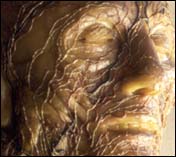
|

Detail of 'Portraits in Wax'. Photograph by Rosamond Purcell,
© 2000.
Click
for a larger, full image.
|
|
Portraits
in Wax
The tradition of fine
wax portraiture began in Italy as early as the 13th century. At
that time, well-to-do patrons often commissioned artists to construct
life-sized portraits of them for display in churches, thus revealing
their personal and social power and prestige. Many finely-crafted
wax models from the 19th-century are currently in medical collections
in Europe and at the Mutter museum in Philadelphia, among other
places in the U.S.
Some of these wax portraits
were modeled from people who suffered from identifiable medical
conditions. In the late 17th century, the sculptor Zumbo, having
witnessed the devastating effects of the bubonic plague in both
Naples and Venice, made small allegorical scenes in which he depicted‹in
wax‹the effects of disease on human beings. The anatomical waxes
in other museum collections came after Zumbo, but the lifelike depictions
of various diseases remind me of his work.
Some very fine specimens
depict rashes, pox, diseases of the eye, and other skin conditions.
This wax head of a boy, sculpted by Guiseppe Astoni in the 19th-century,
displays the effects of a skin disease.
|

|

Detail of 'Wax Medical Model'. Photograph by Rosamond
Purcell, © 2000.
Click
for a larger, full image.
|
|
|

Wax Medical Model
This head comes from
the Medical School collection in Madrid. The veins, arteries, and
nerves of the neck and head are beautifully rendered in wax. Anatomical
wax models like this one were used to teach anatomy to young doctors
in the 19th century.
|
The
Revealing Bodies exhibition at the Exploratorium features an
18th-century wax anatomical model of a female, on loan from
Museo La Specola in Florence. Known as a "medical Venus," it
was created by the renowned Italian artist Suisini. This model,
which revels perfectly rendered organs, has never before been
shown outside Florence.
|
|

